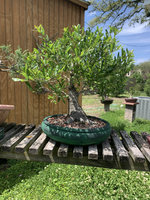You are using an out of date browser. It may not display this or other websites correctly.
You should upgrade or use an alternative browser.
You should upgrade or use an alternative browser.
" I can't believe it's not clay." concrete pot
- Thread starter Joe Dupre'
- Start date
Bnana
Chumono
Nice, which method did you use? Do you have a link to the video you followed?
Joe Dupre'
Omono
Here's the link to Youtube. It's , more or less, what I did.
Pitoon
Imperial Masterpiece
You could use Mason stain to color the Portland cement, then no need to paint.
Joe Dupre'
Omono
Thanks, Pitoon. I'll probably try staining in the future.
Joe Dupre'
Omono
For the first one, I left out the super-smooth cement/water finish coat. I figured my less-than-perfect rendition would be better off if left a little rustic.
Forsoothe!
Imperial Masterpiece
If you want to color your cement pots you can buy colorants for concrete from brick & concrete supply houses in small bags that are used in pigmenting mortor, used as one or more bags of pigment per brick layer's cement mixer batch to match the motor to the brick. But also use Federal White cement and silica sand which is white instead of regular portland which is grey and ordinary sand which is whatever color the local quarry yields. It is easier to overcome the white than the grey. You'll want to use 6% or less pigment and try to keep the amount of water as low as you can to achieve the highest strength. The (portland) cement is just there to bind (glue) the aggregate together, so try to keep the ratio of sand as high as possible, too. And just like in baking, add the dry to the water while mixing and keep adding the dry as the mix becomes more plastic.
RJG2
Omono
Lazylightningny
Masterpiece
How do these concrete pots handle repeated winter freezing? Should be ok I imagine.
Pitoon
Imperial Masterpiece
I would reinforce the pots with some internal wire. TIG welding rods should work perfect for acting as 'rebar' within the cement.How do these concrete pots handle repeated winter freezing? Should be ok I imagine.
Forsoothe!
Imperial Masterpiece
A lot will depend upon how close the maker is able to keep a standard formula ratio of water to cement (cement means Portland Cement: when mixed with water and aggregate it becomes concrete), and if the parts are able to pass through the heat cycle necessary to thoroughly cure the item. A small item having low mass won't generate enough heat to do it and may need to be helped by putting it into a black plastic bag and leaving it in the sun. The water in the mix can't be allowed to "dry" out, it evolves into the molecular structure if the heat necessary is present, hence the sun-heat-absorbing bag that keeps the moisture in. It should stay sealed in the bag for several days or a week and will still remain damp until all the water is used in the molecule building process. Cement itself is not very strong, the real strength lays in the aggregate, crumbly materials will fall apart and bigger particles, like gravel, is much stronger. A stone the size of a Tylenol tablet can displace hundreds of grains of sand. The stone doesn't need any cement to hold the stone together. The grains of sand of that same displacement needs to have cement in all the spaces between grains to make it a whole, dense mass, but that mass does not have nearly as good of bond as the molecules within the stone. Larger aggregate also contribute to a "wetter" mix because it takes less cement by the same volume as the volume of the stones. The mix only has to fill in the space between the stones and most of that will be the grains of sand. Typical roads use larger grains of sand, like #3 grade instead of 000 silica used in white motor. A good combination of sand sizes and larger stones (gravel) fills up more space with aggregate requiring less cement to bond it all together. You can see that without gravel, the concrete will not be as strong, and will use more cement and water to be plastic. The strength in concrete comes from the aggregate being held in place by the cement, not from the strength of the cement.
Joe Dupre'
Omono
We don't get many hard freezes here. We may have 5 days below freezing in an average year. This year we got to 18 F on one day and the temps stayed below freezing for 48 hours. No pots were harmed . I had 3-4 older concrete pots that made it through fine.How do these concrete pots handle repeated winter freezing? Should be ok I imagine.
Hi Joe and thanks for posting. Where did that tool they are using to make those lines around the pot come from if you know. ThanksHere's the link to Youtube. It's , more or less, what I did.
Joe Dupre'
Omono
It’s just a piece of aluminum siding cut to shape. You can make most any shape you want.
Crazy Diamond
Omono
Joe Dupre'
Omono
Peconomou
Yamadori
Looks awesome! Great shape and color!
Joe Dupre'
Omono
Live oaks normally keep most of their leaves and drop some and grow new ones in spring. This one was about bare 3 weeks ago, then.......BINGO! Filled out almost overnight.Nice!
That is possibly the most mature 4 year-old I’ve seen.
I just looked back in my records. It was collected in Jan 2019.......so 3 whole growing seasons plus a couple of months.
Last edited:
Similar threads
- Replies
- 2
- Views
- 303
- Replies
- 6
- Views
- 467
- Replies
- 50
- Views
- 5K
- Replies
- 8
- Views
- 797



